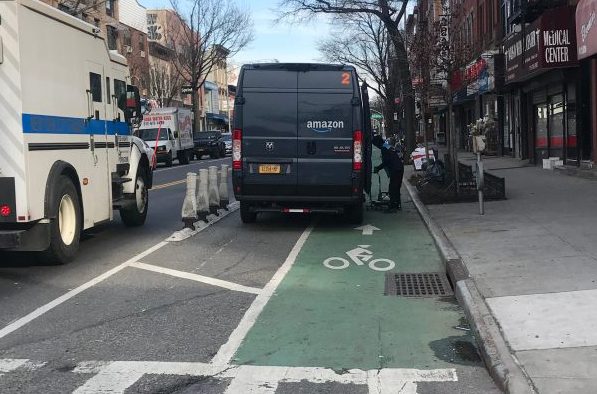New Jersey is doing bike laps around New York, again.
Jersey City will beef up all its protected bike lanes next year by swapping out the flimsy flex-posts that currently line them and replacing them sturdy jersey barriers, its mayor announced on Twitter this week — another sign that the Garden State is ahead of New York when it comes to building out truly safe bike infrastructure.
The latest announcement by Mayor Steven Fulop, who runs the roughly 260,000-person city on the other side of the Hudson River, comes after Jersey City moved ahead in creating bike parking and vowing to quadruple cycling in Chilltown by 2025. Fulop said that only stronger physical barriers will keep cyclists safe.
“We are in the process of buying jersey barriers for all of our protected bike lanes. We are planning on moving from flex posts to more substantial protection in 2022. ... We think it will be safer for the network + cheaper in long term,” he said on Twitter.
We are in the process of buying jersey barriers for all of our protected bike lanes. We are planning on moving from flex posts to more substantial protection in 2022. Pricing is coming back now to make the change as we think it will be safer for the network + cheaper in long term https://t.co/7BNzKZcgqQ
— Steven Fulop (@StevenFulop) October 5, 2021
New York City's own flexible delineators — which the Department of Transportation counts as qualifying the pathway as part of the city's 546 miles of protected bike lanes — have been the center of much ire from activists and cyclists who warn that they do little to protect riders from speeding and reckless motorists. Many miles of the city's bike lanes are protected by parked cars, and others actual concrete barriers — like on Prospect Park West and the new Brooklyn Bridge bike lane — but the exact number of those that are truly protected by strong physical barriers versus the flexible delineators (or merely a wide painted buffer) is not clear.
The Grand Street bike lane in Brooklyn, for example, is regularly filled with delivery trucks, for-hire vehicles, and other private vehicles that either pull right into — or over — the bendable plastic bollards that do little to discourage drivers from riding in the bike lane.

And on Crescent Street in Queens, cyclists similarly have been sounding the alarm about the two-way bike lane’s lack of physical barriers to keep riders safe from speeding drivers. Last November, the driver of a massive beer distribution truck fatally struck 35-year-old scooter rider Alfredo Cabrera Liconia on Crescent Street near Astoria Boulevard. Video from the scene shows the truck’s front wheels in the green paint, which, activists said at the time, would be impossible if the lane was truly protected.
https://twitter.com/macartney/status/1316202700334301184?ref_src=twsrc%5Etfw%7Ctwcamp%5Etweetembed%7Ctwterm%5E1316410742539722752%7Ctwgr%5E%7Ctwcon%5Es2_&ref_url=https%3A%2F%2Fnyc.streetsblog.org%2F2020%2F11%2F12%2Ftruck-driver-kills-scooter-rider-near-new-queens-protected-bike-lane%2F
Fulop said his administration has already coughed up about $400,000 to replace broken flex-posts, but that trading them in for something sturdier like concrete jersey barriers will ultimately be more cost effective. Fulop said bids for the heavier barriers are coming in at around $2 million to outfit all of the city's protected bike lanes by 2022.
“[The flex posts are] expensive — they get knocked down almost immediately," he said. "Let’s get more permanent barriers in place, it’s more cost effective and safer."
Fulop, who laughed (and declined to comment) when asked what he thinks of Mayor de Blasio’s track record on building bike infrastructure, said it’s “common sense” to make sure cyclists feel as safe as possible, and that his administration never does anything half-way.
“We pride ourselves that once we commit to something we do it properly and do it quickly,” said Fulop, who was recently honored for his bike advocacy by the New Jersey Bike and Walking Coalition. "Bike infrastructure is one of those things we’re not gonna do half-assed. I can’t speak about the NY government. It’s common sense to have protected lanes, otherwise people won't use them."
Bike New York's Jon Orcutt, who has long sounded the alarm over the importance of installing truly safe bike lanes, hailed Fulop and, implicitly criticized the de Blasio administration.
“It’s fantastic to see a leader of a city saying clearly that flex-posts are a bad use of money because they don't work to protect cyclists," said Orcutt. “I’ve been pounding the pavement on quality versus quantity for a long time. Right now we’re building out a protected bike lane network with plastic sticks. It’s basically like digging holes and filling them back up."
Jersey City announced in 2019 that it would build more than 54 miles of bike lanes — 19 of them shared lanes (by comparison, much larger New York City has 1,375 miles of bike lanes, 546 of them so-called protected). Fulop said the city built out 10 miles of protected bike lanes last year, and plans to roll out another 10 next year.
Jersey City is also the center of a bike parking revolution that's desperately needed in the five boroughs. Streetsblog reported last month that Oonee is expanding with 1,500 new spaces by the end of next year, with 29 of the company’s pods in Jersey City, and just seven in New York City.






